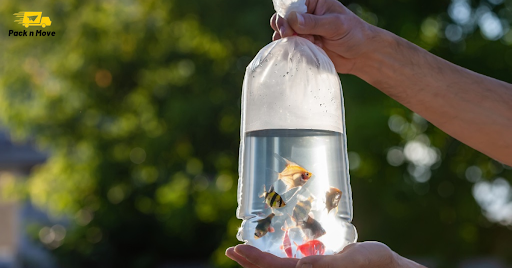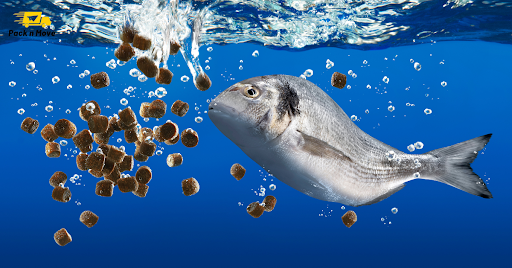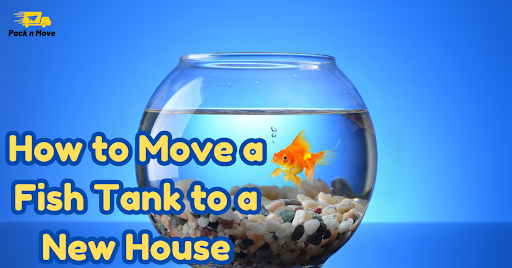Moving a fish tank to a new house may seem like a daunting task, but with careful planning and proper execution, it can be done successfully. Fish are delicate creatures, and their aquarium environment needs special care to ensure they stay healthy and stress-free during the transition. This guide provides a step-by-step approach to moving your fish tank safely, from preparation to post-move setup.
Whether you’re dealing with a glass aquarium, a freshwater tank, or a setup with exotic species like clownfish, this comprehensive guide ensures a smooth move for both you and your aquatic pets.
Plan Ahead for a Smooth Fish Tank Move
Assess Your Moving Options
Before jumping into the logistics, decide how you want to handle the move. Moving a fish tank is not like relocating furniture—it requires meticulous care and preparation. You can choose between two main options: doing it yourself (DIY) or hiring professional fish tank movers. For smaller tanks and short-distance moves, DIY might be manageable. However, larger tanks or more complex setups may benefit from professional assistance.
If you decide to hire movers, ensure they have experience in fish tank relocation. Some local pet stores may recommend reliable professionals who understand the nuances of transporting aquarium accessories and fragile fish tank equipment like heaters, filters, and light fixtures. Doing your research early will save time and prevent mishaps during the move.
Decide Whether to DIY or Hire Professionals
When planning to move your fish tank setup yourself, evaluate the tools and resources you’ll need. This includes containers for the fish, packing materials for the tank, and a suitable vehicle to transport it all. If you’re confident in your ability to safely handle these elements, DIY can save you money. However, professional movers come with the advantage of expertise, especially for intricate setups or moving exotic pets. Weigh your options carefully to decide the best course of action.
Gather Essential Supplies for the Move
Packing Materials for the Tank
To protect your tank during the move, gather sturdy cardboard boxes, bubble wrap, furniture blankets, and plenty of packing tape. These materials will prevent cracks and scratches on the glass surface of your tank. Additionally, ensure you have packing paper for wrapping fragile items like aquarium decorations, which might include pirate ships, NO FISHING signs, or unique stones.
For a glass aquarium, padding is key to prevent damage during transit. Use bubble wrap generously around the tank and secure it with tape. Place the tank upright in a box lined with furniture blankets for added protection. Fragile elements, such as aquarium heaters or pumps, should be packed separately with care.
Containers for Fish and Aquarium Items
The health and safety of your fish depend on proper containment during the move. Use plastic buckets or temporary moving containers to transport them. These containers should have lids to prevent spills but allow for some airflow. Fill them with conditioned tap water from the tank to maintain the biological balance and reduce fish stress.
Don’t forget to pack additional items like aquarium gravel, filters, and pumps in separate containers to avoid mixing. Label everything clearly to make reassembly easier in your new home. Having the right supplies will minimize the risk of damage and ensure a smoother transition for your aquatic pets.
Prepare Your Fish for Transport
Temporarily House Your Fish in Safe Containers
Moving day can be stressful for your fish, so providing a secure temporary home is essential. Start by transferring your fish to plastic buckets or sealed bags filled with water from the aquarium. This ensures the water chemistry remains familiar, reducing the likelihood of shock or stress. A fish net can be used to gently catch and move the fish without injury.
Ensure the containers are clean and free from harmful substances. If you’re moving freshwater aquarium fish, consider separating species with unique needs. Label each container to avoid confusion and place them in a stable, temperature-controlled area.
Minimize Stress During the Transition
Fish are highly sensitive to changes in their environment. To reduce stress during the move, keep their containers in a dark, quiet space. Cover the containers lightly with a cloth or towel to mimic their natural habitat and keep them calm. Transport them carefully to avoid sudden movements or temperature fluctuations, as these can impact their health.
Safely Empty and Pack the Fish Tank

Remove Equipment and Decorations
Before packing the tank, remove all fish tank equipment and decorations. Items such as filters, heaters, pumps, and light fixtures should be carefully unplugged, cleaned, and dried. Wrap these components in packing paper or bubble wrap to prevent damage during transit. Keep small items like aquarium decorations (e.g., pirate ships and plants) in labeled bags for easy identification.
Ensure that all decorations, gravel, and sand are removed from the tank. Cleaning these items before the move will make the reassembly process easier and maintain the integrity of the aquarium water transfer once you’re ready to set up in your new home.
Siphon Water and Clean the Tank
Using a siphon hose, remove most of the water from the tank, leaving a small amount to keep the aquarium gravel moist. This helps preserve beneficial bacteria that contribute to the tank biological balance. Avoid cleaning the tank with harsh chemicals; instead, rinse it with conditioned tap water to avoid introducing harmful substances.
Once the tank is emptied, clean it thoroughly to remove any debris or algae. Allow it to dry completely before packing it securely for the move. A clean tank not only prevents odors but also ensures a healthier environment for your fish when you set it up again.
Pack and Transport the Fish Tank
Use Padding to Prevent Damage
Packing the tank is a critical step to ensure it arrives in one piece. Wrap the tank in multiple layers of bubble wrap, paying extra attention to the corners and edges. Secure the wrap with packing tape and place the tank inside a sturdy box. Line the box with furniture blankets or foam padding to absorb shocks during transit.
Ensure that the tank is transported upright to prevent stress on the glass. Place the packed tank in the moving truck where it won’t shift or be crushed by heavier items. Clearly mark the box as fragile to avoid mishandling.
Keep the Tank Upright and Stable
Stability is key during transportation. Secure the tank in the truck to prevent it from sliding or tipping over. Avoid placing heavy items on top of the tank, even if it’s packed securely. For longer moves, check periodically to ensure the tank remains stable and free from damage.
Reassemble and Set Up the Tank in Your New Home
Refill the Tank and Test Water Quality
Once you’ve arrived, prioritize reassembling the tank. Begin by placing it in its designated spot, away from direct sunlight or high-traffic areas. Add the dechlorinated water gradually, ensuring the temperature and pH levels are suitable for your fish. Reinstall the fish tank equipment, including heaters, filters, and light fixtures, to restore the aquarium environment.
Test the water quality using a kit to ensure the levels of ammonia and nitrite are safe. Maintaining optimal conditions is crucial for the health of your fish and the stability of the tank’s ecosystem.
Gradually Reintroduce Your Fish
Let the fish acclimatize to their new environment by floating their containers in the tank for about 15-20 minutes. This step equalizes the temperature and prevents shock. Once acclimated, gently release the fish into the tank using a fish net. Monitor them closely during the first few hours to ensure they adjust well.
Post-Move Care for Your Fish

Monitor Fish Behavior for Signs of Stress
After the move, your fish may exhibit signs of stress, such as hiding, reduced activity, or loss of appetite. Keep an eye on their behavior and address any issues promptly. Adjust the tank’s settings as needed to maintain a stable environment.
Adjust Aquarium Settings as Needed
Check all aquarium accessories, such as filters and heaters, to ensure they’re functioning properly. Regular maintenance and water changes will help restore the tank’s equilibrium and support your fish’s recovery from the move.
Conclusion
Moving a fish tank may seem like a big challenge, but with careful planning and attention to detail, it can be done successfully. From gathering supplies to reassembling the tank, each step plays a vital role in ensuring your fish stay safe and stress-free. By following this guide, you’ll create a seamless transition for your aquatic pets, making their new home just as comfortable as the old one.
Frequently Asked Questions (FAQs)
- Can I move my fish tank without emptying it?
No, moving a full tank can damage the glass and strain the structure. Always empty the tank before moving. - How long can fish stay in temporary containers?
Fish can safely remain in temporary containers for up to 24 hours if water conditions are maintained. - Should I replace the gravel after the move?
No, keeping the gravel helps preserve beneficial bacteria essential for the tank’s ecosystem. - How can I reduce fish stress during the move?
Minimize noise, temperature changes, and sudden movements. Keep fish in a dark, stable environment during transit. - Can I set up the tank immediately after the move?
Yes, but ensure water quality is tested and equipment is reinstalled before reintroducing your fish.
